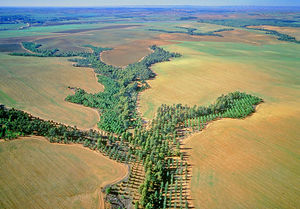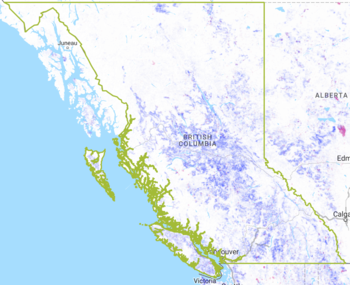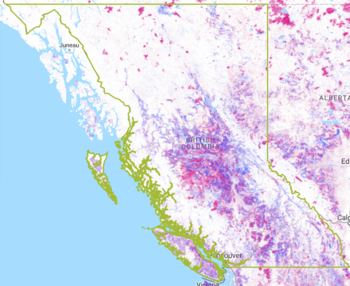Afforestation: Difference between revisions
m (1 revision imported: Fixing the uploaded category problem) |
m (1 revision imported) |
||
| (One intermediate revision by one other user not shown) | |||
| Line 1: | Line 1: | ||
[[Category:Done | [[Category:Done 2020-01-31]] | ||
[[File:tama22_cover.jpg|300px|thumbnail|right|Figure 1: Strategically planted trees in a previously not forested area in Israel.<ref>Shlomo Aronson Architects (2010). National Outline Plan for Afforestation [Online]. Available: http://www.s-aronson.co.il/project/national-master-plan-for-afforestation-tama-22/</ref>]] | [[File:tama22_cover.jpg|300px|thumbnail|right|Figure 1: Strategically planted trees in a previously not forested area in Israel.<ref>Shlomo Aronson Architects (2010). National Outline Plan for Afforestation [Online]. Available: http://www.s-aronson.co.il/project/national-master-plan-for-afforestation-tama-22/</ref>]] | ||
<onlyinclude>'''Afforestation''' is the process of introducing trees and tree seedlings to an area that has previously not been forested.</onlyinclude> Afforestation can be done through tree planting and seeding naturally or artificially.<ref>IPCC. Afforestation, Reforestation and Deforestation, Afforestation [Online]. Available: http://www.ipcc.ch/ipccreports/sres/land_use/index.php?idp=47</ref> Similarly, '''reforestation''' can be considered a form of afforestation | <onlyinclude>'''Afforestation''' is the process of introducing trees and tree seedlings to an area that has previously not been forested.</onlyinclude> Afforestation can be done through tree planting and seeding, naturally or artificially.<ref>IPCC. Afforestation, Reforestation and Deforestation, Afforestation [Online]. Available: http://www.ipcc.ch/ipccreports/sres/land_use/index.php?idp=47</ref> | ||
Similarly, '''reforestation''' can be considered a form of afforestation. Reforestation is the alteration of a non-forested area to a forested area through tree planting and seeding. The difference is that reforestation is the '''restoration''' of an area that has been deforested.<ref>IPCC. Land Use, Land-Use Change and Forestry, Reforestation [Online]. Available: http://www.ipcc.ch/ipccreports/sres/land_use/index.php?idp=48 </ref><ref>IPCC, “Renewable Energy Sources and Climate Change Mitigation,” IPCC., Postdam Institute for Climate Impact Research, ISBN 978-92-9169-131-9. Glossary, Acronyms, Chemical Symbols and Prefixes, pg. 162.</ref> | |||
==Purposes of Afforestation== | ==Purposes of Afforestation== | ||
There are many reasons for restoring an area via afforestation and reforestation, however they vary based on the area. Generally it is done for either conservation or industrial-commercial purposes. | There are many reasons for restoring an area via afforestation and reforestation, however they vary based on the area. Generally it is done for either conservation or industrial-commercial purposes. | ||
*Conservational afforestation and reforestation is done in the best interest of the [[ecosystem]]. Its purpose is to restore an area that has been destroyed due to previous overuse of the land or to reduce the amount of [[erosion]] in the [[soil]] in an area and establish a more fertile soil base. | *'''Conservational''' afforestation and reforestation is done in the best interest of the [[ecosystem]]. Its purpose is to restore an area that has been destroyed due to previous overuse of the land or to reduce the amount of [[erosion]] in the [[soil]] in an area and establish a more fertile and stable soil base. | ||
*Industrial-commercial afforestation and reforestation is done to maintain a good output of wood for pulp and timber demands in a specific area.<ref>Afforestation, Reforestation and Forest Restoration in Arid and Semi-arid Tropics, A Manual of Technology and Management, P.R. Siyag, Bonn, Germany, 2014, pp. 3-11.</ref> | *'''Industrial-commercial''' afforestation and reforestation is done to maintain a good output of wood for pulp and timber demands in a specific area.<ref>Afforestation, Reforestation and Forest Restoration in Arid and Semi-arid Tropics, A Manual of Technology and Management, P.R. Siyag, Bonn, Germany, 2014, pp. 3-11.</ref> | ||
==Impacts of Afforestation== | ==Impacts of Afforestation== | ||
| Line 11: | Line 14: | ||
==Issues Affecting Afforestation== | ==Issues Affecting Afforestation== | ||
Some issues that can arise from afforestation and reforestation is [[climate change]], anthropogenic changes to landscape and increased wood demand. Climate change can have some major effects on the growth and health | Some issues that can arise from afforestation and reforestation is [[climate change]], anthropogenic changes to landscape and increased wood demand. Climate change can have some major effects on the growth and health of newly planted trees. [[Drought]] and major [[temperature]] fluctuations can cause serious seedling mortality to an area that has been newly planted, ultimately slowing down the restoration process. To reduce the effects of climate change on the restoration process, drought and shade tolerant species are used.<ref> S.S. Lawson, C.H. Michler, “Afforestation, Restoration and Regeneration – Not all trees are created equal,” Journal of Forestry Research, Northeast Forestry University and Springer, Berlin, Germany, Review Article, DOI 10.1007/s11676-014-0426-5, Nov. 2013.</ref> | ||
Increasing wood demand is another problem. The rate at which trees are being planted is much slower than the rate of those being cut down for production. The trees need time to grow and without a properly timed planting seasons going hand in hand with deforestation, there can be a potential stasis for the ever increasing wood demand. | Increasing wood demand is another problem. The rate at which trees are being planted is much slower than the rate of those being cut down for production. The trees need time to grow and without a properly timed planting seasons going hand in hand with deforestation, there can be a potential stasis for the ever increasing wood demand. | ||
| Line 18: | Line 21: | ||
[[File:2001.png|350px|thumbnail|left|Figure 2: In 2001 the total tree cover loss was 200 000 ha]][[File:2001-2014.png|350px|thumbnail|centre|Figure 3: From 2001 to 2014 the total tree cover loss was 5 000 000 ha]] | [[File:2001.png|350px|thumbnail|left|Figure 2: In 2001 the total tree cover loss was 200 000 ha]][[File:2001-2014.png|350px|thumbnail|centre|Figure 3: From 2001 to 2014 the total tree cover loss was 5 000 000 ha]] | ||
<br /> | <br /> | ||
==For Further Reading== | |||
*[[Biofuel]] | |||
*[[Renewable and sustainable energy]] | |||
*[[Forest fire]] | |||
*[[Climate change consequences on rainforests]] | |||
==References== | ==References== | ||
{{reflist}} | {{reflist}} | ||
[[Category: Uploaded]] | [[Category: Uploaded]] | ||
Latest revision as of 05:10, 31 January 2020

Afforestation is the process of introducing trees and tree seedlings to an area that has previously not been forested. Afforestation can be done through tree planting and seeding, naturally or artificially.[2]
Similarly, reforestation can be considered a form of afforestation. Reforestation is the alteration of a non-forested area to a forested area through tree planting and seeding. The difference is that reforestation is the restoration of an area that has been deforested.[3][4]
Purposes of Afforestation
There are many reasons for restoring an area via afforestation and reforestation, however they vary based on the area. Generally it is done for either conservation or industrial-commercial purposes.
- Conservational afforestation and reforestation is done in the best interest of the ecosystem. Its purpose is to restore an area that has been destroyed due to previous overuse of the land or to reduce the amount of erosion in the soil in an area and establish a more fertile and stable soil base.
- Industrial-commercial afforestation and reforestation is done to maintain a good output of wood for pulp and timber demands in a specific area.[5]
Impacts of Afforestation
Afforestation, reforestation and other forms of conservational forestry methods are often thought to be used for stopping the effects of climate change by reducing atmospheric carbon. The issue is which type of tree sequesters the most amount of carbon and does this have a positive or negative effect if any at all? The tree types that are widely discussed are old growth vs young-growth forests. Old growth forests are said to have massive carbon storage capabilities however these trees are capturing carbon incredibly slowly or unable to capture any more. With reforestation, this process is ‘solved’ by cutting down old growth and planting young-growth trees. Unfortunately, when an old growth forest is cut down, a lot of the stored carbon gets released into the atmosphere thus preventing a net positive effect. Afforestation is being thought of as a solution to the reforestation issue. By planting a new young-growth forest in an area that hasn’t previously had a forested, this could be a viable option for sequestering more carbon from the atmosphere. However, planting trees in an area previously unforested could impact the original ecosystem negatively such as reducing soil moisture in an area and forcing many species to leave their preferred habitats.[6]
Issues Affecting Afforestation
Some issues that can arise from afforestation and reforestation is climate change, anthropogenic changes to landscape and increased wood demand. Climate change can have some major effects on the growth and health of newly planted trees. Drought and major temperature fluctuations can cause serious seedling mortality to an area that has been newly planted, ultimately slowing down the restoration process. To reduce the effects of climate change on the restoration process, drought and shade tolerant species are used.[7]
Increasing wood demand is another problem. The rate at which trees are being planted is much slower than the rate of those being cut down for production. The trees need time to grow and without a properly timed planting seasons going hand in hand with deforestation, there can be a potential stasis for the ever increasing wood demand.
Climate change is also changing the success of pests like the mountain pine beetle. In North America, as temperatures rise in the west and winters are becoming warmer, the pine beetle populations aren't dying out as they are supposed to in the winter. Figures 2 and 3 below show the difference between tree cover gain and loss in British Columbia from 2001 to 2014 taken from the global forest watch interactive map. The pink dots represent tree cover loss and the blue dots represent tree forest gain.[8]
For Further Reading
References
- ↑ Shlomo Aronson Architects (2010). National Outline Plan for Afforestation [Online]. Available: http://www.s-aronson.co.il/project/national-master-plan-for-afforestation-tama-22/
- ↑ IPCC. Afforestation, Reforestation and Deforestation, Afforestation [Online]. Available: http://www.ipcc.ch/ipccreports/sres/land_use/index.php?idp=47
- ↑ IPCC. Land Use, Land-Use Change and Forestry, Reforestation [Online]. Available: http://www.ipcc.ch/ipccreports/sres/land_use/index.php?idp=48
- ↑ IPCC, “Renewable Energy Sources and Climate Change Mitigation,” IPCC., Postdam Institute for Climate Impact Research, ISBN 978-92-9169-131-9. Glossary, Acronyms, Chemical Symbols and Prefixes, pg. 162.
- ↑ Afforestation, Reforestation and Forest Restoration in Arid and Semi-arid Tropics, A Manual of Technology and Management, P.R. Siyag, Bonn, Germany, 2014, pp. 3-11.
- ↑ Forest Sequestration Controversy: Old-Growth vs. Young-Growth Forests as Viable Carbon Offsets [Online]. Available: http://oldvsyounggrowthforestasoffset.weebly.com/pros-and-cons.html
- ↑ S.S. Lawson, C.H. Michler, “Afforestation, Restoration and Regeneration – Not all trees are created equal,” Journal of Forestry Research, Northeast Forestry University and Springer, Berlin, Germany, Review Article, DOI 10.1007/s11676-014-0426-5, Nov. 2013.
- ↑ Global Forest Watch (2016). Interactive Map [Online]. Available: http://www.globalforestwatch.org/embed/map/8/58.20/-134.21/CAN-2/grayscale/loss,forestgain?tab=analysis-tab&begin=2014-01-01&end=2015-01-01&threshold=30



